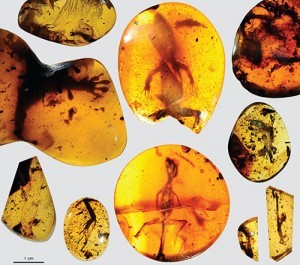By Ana Verayo, | March 06, 2016

These ancient amber fossils from Myanmar in Southeast Asia provide a look at “missing links” in the evolutionary history of lizards.
Scientists reveal two specimens of ancient lizards, so ancient that it has been locked away for 99 million years, fossilized in amber, providing a glimpse of the prehistoric world.
These reptilian creatures have been exquisitely preserved with amazing detail, that reveal the scales of its skin and even its tongue tip and tiny claws. These fossils belong to the ancient ancestors of modern day geckos and chameleons, that reveal common features such as toe pads that are able to stick onto surfaces. These lizards also once thrived in ancient tropical forests which is now known as Myanmar in Southeast Asia, during the Mid-Cretaceous period.
Like Us on Facebook
According to Edward Stanley from the Florida Museum of Natural History, fossilized amber that carry specimens offers a peek into a lost world, that can reveal a lot of secrets of life in the tropics during the Mid-Cretaceous period, that boasted a diverse, lizard world.
These prehistoric lizards survived by evolving into modern species such as geckos where others apparently did not evolve into modern day versions, eventually dying out.
Stanley says that one of the fossils appears to show some clues about the transitional lizard form between a "standard" lizard and chameleons. He adds how this "missing link" is 80 million years older than the latest oldest chameleon fossil ever uncovered, which reveals features that are similar to the projectile tongue of the modern chameleon. It also shows odd, fused toes that may have been adapted for climbing long branches that were evolved later.
These amber fossils have been in private collections in museums around the United States where they have been consolidated and examined for the first time by scientists.
According to lead author of the study, Juan Diego Daza from the Sam Houston State University in Texas, these amber specimens provide crucial details of external morphology which have been extremely rare to find.
He explains that these fossils represent how diverse lizards are, with the most excellent amount of detail. The soft tissues, internal organs and bones can exist within amber for millions of years, as Daza adds that this is almost like looking back at the time when they were alive.
The amber specimens involve smaller ones of entire lizards while others are just parts of bodies that are encased inside animals. Now, these new findings can provide missing information about the family tree of ancient reptiles including their modern counterparts.
This study is published in the journal Science Advances.
-
Use of Coronavirus Pandemic Drones Raises Privacy Concerns: Drones Spread Fear, Local Officials Say

-
Coronavirus Hampers The Delivery Of Lockheed Martin F-35 Stealth Fighters For 2020

-
Instagram Speeds Up Plans to Add Account Memorialization Feature Due to COVID-19 Deaths

-
NASA: Perseverance Plans to Bring 'Mars Rock' to Earth in 2031

-
600 Dead And 3,000 In The Hospital as Iranians Believed Drinking High-Concentrations of Alcohol Can Cure The Coronavirus

-
600 Dead And 3,000 In The Hospital as Iranians Believed Drinking High-Concentrations of Alcohol Can Cure The Coronavirus

-
COVID-19: Doctors, Nurses Use Virtual Reality to Learn New Skills in Treating Coronavirus Patients







